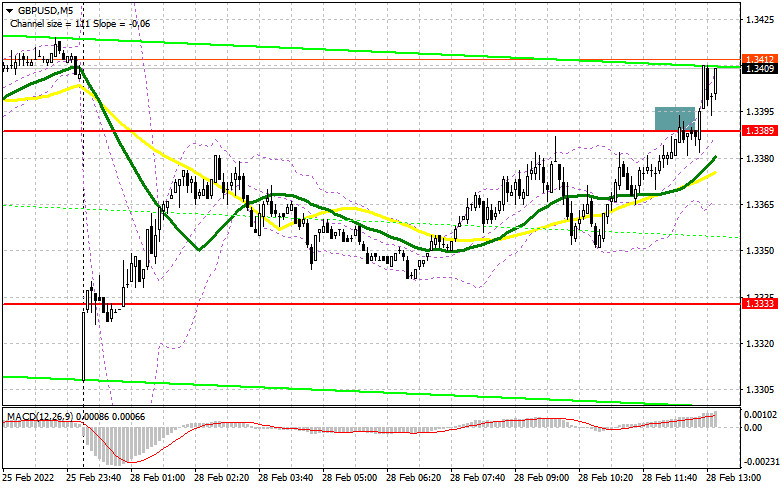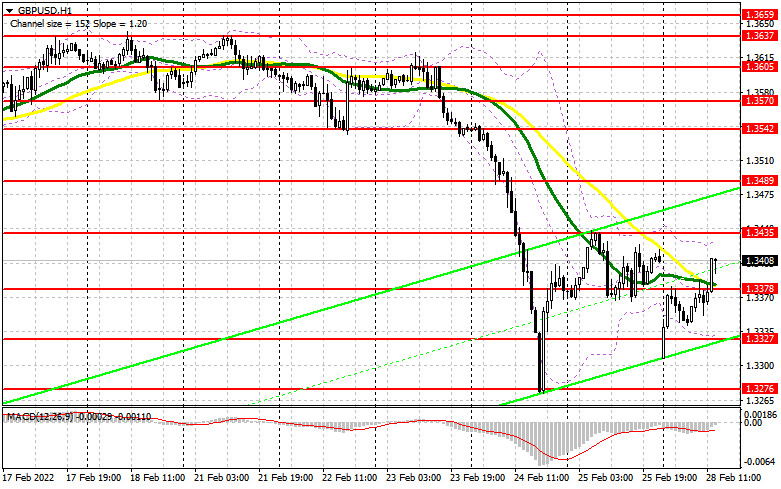
To open long positions on GBP/USD, you need:
In my morning forecast, I paid attention to the level of 1.3389 and recommended making decisions on entering the market. Let's look at the 5-minute chart and figure out what happened. Demand for the pound persisted at the beginning of the European session after the largest drop in Asian trading, which led to a resistance test of 1.3389. Unfortunately, there were no active actions of sellers at this level, although a false breakdown and a sell signal were formed. It was quite possible to count on the resumption of the fall of the pound, especially against the background of everything that is happening in the world right now. From a technical point of view, the picture has changed for the second half of the day. And what were the entry points for the euro this morning?

The actions of Russian troops on the territory of Ukraine continue to put serious pressure on the euro, but the good news about the start of negotiations, of course, will warm up the markets. It is quite possible that the buyers of the pound took advantage of this moment, gaining several long positions at attractive prices after the morning sale. In the afternoon, although several fundamental statistics on the American economy are released, including reports on the balance of foreign trade in goods and changes in the volume of stocks in wholesale warehouses in the United States, however, all attention will be tied to the results of the meeting, which is unknown when it will end and how it will end. The key task of the bulls in the afternoon will be to protect the new support level of 1.3378, formed at the end of the European session. The most optimal option, of course, will be purchases in case of a false breakdown at the level of 1.3378, but immediately after that, there should be an active growth of the pair. If it is not there, and the data for the US are coming out very good, I advise you to postpone long positions to a minimum of 1.3327. Only the formation of a false breakdown there will give an entry point to long positions. You can buy the pound immediately on a rebound from 1.3276, or even lower - from a minimum of 1.3232, counting on a correction of 20-25 points within a day. To stop the bearish trend, bulls need to try to close the day above 1.3435, which will completely block the bearish gap. It will not be so easy to do this, especially since the outcome of the negotiations may be unpredictable. A breakthrough and a test of 1.3435, even after very weak US data, will not lead to a sharp increase in the pound. If the breakdown of 1.3435 still takes place, we can count on further growth of GBP/USD in the area of the highs: 1.3489 and 1.3542.
To open short positions on GBP/USD, you need:
Bears are not showing much activity yet, which is very strange - especially during such a nervous market. In no case should they allow the day to close above 1.3378, as this will return the initiative to buyers? It will also create even more technical problems for traders counting on a further collapse of the pound after today's Asian sell-off. The intensification of military operations on the territory of Ukraine will lead to a new wave of decline in the pair. The formation of a false breakout at 1.3435 is the nearest resistance level, forming an excellent entry point into short positions, followed by a decline and a breakdown of support at 1.3378. The lack of activity on the part of buyers there, as well as a breakdown and a reverse test of this level from the bottom up, will give an additional entry point into short positions to fall to 1.3327 and 1.3276. A more distant target will be the 1.3232 area, where I recommend fixing the profits. If the pair grows during the American session, as well as weak sellers' activity at 1.3435, it is best to postpone sales. The demolition of 1.3435 may lead to a sharp increase in the pound against the background of sellers' stop orders. In this case, I advise you to open short positions of GBP/USD immediately for a rebound from 1.3489, or even higher - around 1.3542, counting on a correction within the day by 20-25 points.

The COT reports (Commitment of Traders) for February 15 recorded a sharp increase in long positions and a reduction in short ones. This led to the return of the delta of its positive value. Although the results of the Bank of England meeting did not come as a surprise, clear hints from the regulator on a more aggressive tightening of the monetary policy fuels the appetite for risks on the part of major players. If it were not for the ongoing conflict between Russia and Ukraine, which has reached a new level - one could count on a more active recovery of the pound. In the meantime, further demand for risky assets is questionable. Given that the British economy is currently going through not the best of times and at any moment the pace of economic growth may seriously slow down - raising rates may harm the pace of recovery in the near future. However, optimism is inspired by the recent good report on retail sales, which implies strong growth in the indicator. The fact that inflation in January remained at the same levels and practically did not change year-on-year - all this may affect the plans of the Bank of England, which will moderate the pace of policy tightening. Further geopolitical events around Russia and Ukraine, as well as the decisive actions of the Federal Reserve System regarding future interest rates in March of this year - all this will continue to put pressure on buyers of the pound. Some traders expect that the US central bank may resort to more aggressive actions and raise rates by 0.5% at once, rather than by 0.25% - this will become a kind of bullish signal for the US dollar. The COT report for February 15 indicated that long non-commercial positions increased from 44,709 to 50,151, while short non-commercial positions decreased from 53,254 to 47,914. This led to an increase in the non-commercial net position from -8,545 to 2,247. The weekly closing price remained unchanged at 1.3532 versus 1.3537.
Signals of indicators:
Moving averages
Trading is conducted around 30 and 50 daily moving averages, which indicates some confusion of traders with the further direction.
Note: The period and prices of moving averages are considered by the author on the hourly chart H1 and differ from the general definition of the classic daily moving averages on the daily chart D1.
Bollinger Bands
In the case of growth, the upper limit of the indicator around 1.3420 will act as resistance. In the case of a decline, the lower limit of the indicator in the area of 1.3330 will provide support.
Description of indicators
Moving average (moving average determines the current trend by smoothing out volatility and noise). Period 50. The graph is marked in yellow.Moving average (moving average determines the current trend by smoothing out volatility and noise). Period 30. The graph is marked in green.MACD indicator (Moving Average Convergence / Divergence - moving average convergence/divergence) Fast EMA period 12. Slow EMA period 26. SMA period 9Bollinger Bands (Bollinger Bands). Period 20Non-profit speculative traders, such as individual traders, hedge funds, and large institutions that use the futures market for speculative purposes and meet certain requirements.Long non-commercial positions represent the total long open position of non-commercial traders.Short non-commercial positions represent the total short open position of non-commercial traders.Total non-commercial net position is the difference between the short and long positions of non-commercial traders.